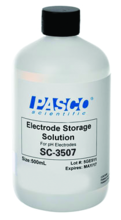Physical or Chemical Change
Students use a pH Sensor, a Conductivity Sensor, and a Temperature Sensor to collect evidence that supports their conclusion about whether a chemical or physical change has occurred.
Supports NGSS Science and Engineering Practice 4: Analyzing and Interpreting Data
Grade Level: High School
Subject: Chemistry
Student Files
| Answer Sheet | 123.42 KB | |
| Physical or Chemical Change | 422.05 KB | |
| Answer Sheet | 146.71 KB | |
| Physical or Chemical Change | 358.98 KB | |
| Physical or Chemical Change Sample Data | 1.18 MB |
Teacher Files
Sign In to your PASCO account to access teacher files and sample data.
Watch Video
Physical or Chemical Change
Use a pH Sensor, a Conductivity Sensor, and a Temperature Sensor to collect evidence that supports a conclusion about whether a chemical or physical change...
Featured Equipment
pH Storage Solution
A 500 mL bottle of storage solution for PASCO pH Electrodes.
Wireless Conductivity Sensor
This waterproof sensor connects via Bluetooth® to measure both conductivity (ionic content in solution) and total dissolved solids.
Wireless pH Sensor
Here’s the best tool for measuring pH since litmus paper. The Wireless pH Sensor connects via Bluetooth® to monitor the pH of solutions.
Wireless Temperature Sensor
The Wireless Temperature Sensor is a general-purpose sensor found in many science labs. With a rugged, waterproof design and a long-lasting battery, students can spend more time collecting data and less time dealing with equipment.
Essential Chemistry Starter Lab Kit
This Starter Lab Station includes the wireless temperature, conductivity, pressure, and pH sensors to perform key lab activities from the Essential Chemistry Student Lab Manual.
Support
Many lab activities can be conducted with our Wireless, PASPORT, or even ScienceWorkshop sensors and equipment. For assistance with substituting compatible instruments, contact PASCO Technical Support. We're here to help.
Copyright © 2018 PASCO
Essential Chemistry Starter Lab Kit
Essential Chemistry Teacher Lab Manual
More Experiments
High School







